University Finance Module: Investment Appraisal Techniques Report
VerifiedAdded on 2021/06/17
|17
|4660
|38
Report
AI Summary
This report provides a comprehensive overview of investment appraisal techniques, essential for financial decision-making. It begins with an introduction to the concept of investment decisions and the factors influencing them, including cash flow, project life, and discounting factors. The report then delves into specific techniques such as Accounting Rate of Return (ARR), Payback Period, Net Present Value (NPV), and Internal Rate of Return (IRR), detailing their calculation methods, decision rules, merits, and demerits. A hypothetical investment scenario is presented, and the techniques are applied to determine the viability of the investment. The report concludes with a discussion of ethical considerations in financial decision-making and provides relevant references. The report offers a detailed analysis of each technique, making it a valuable resource for students studying finance and accounting.

Accounting and finance
Paraphrase This Document
Need a fresh take? Get an instant paraphrase of this document with our AI Paraphraser
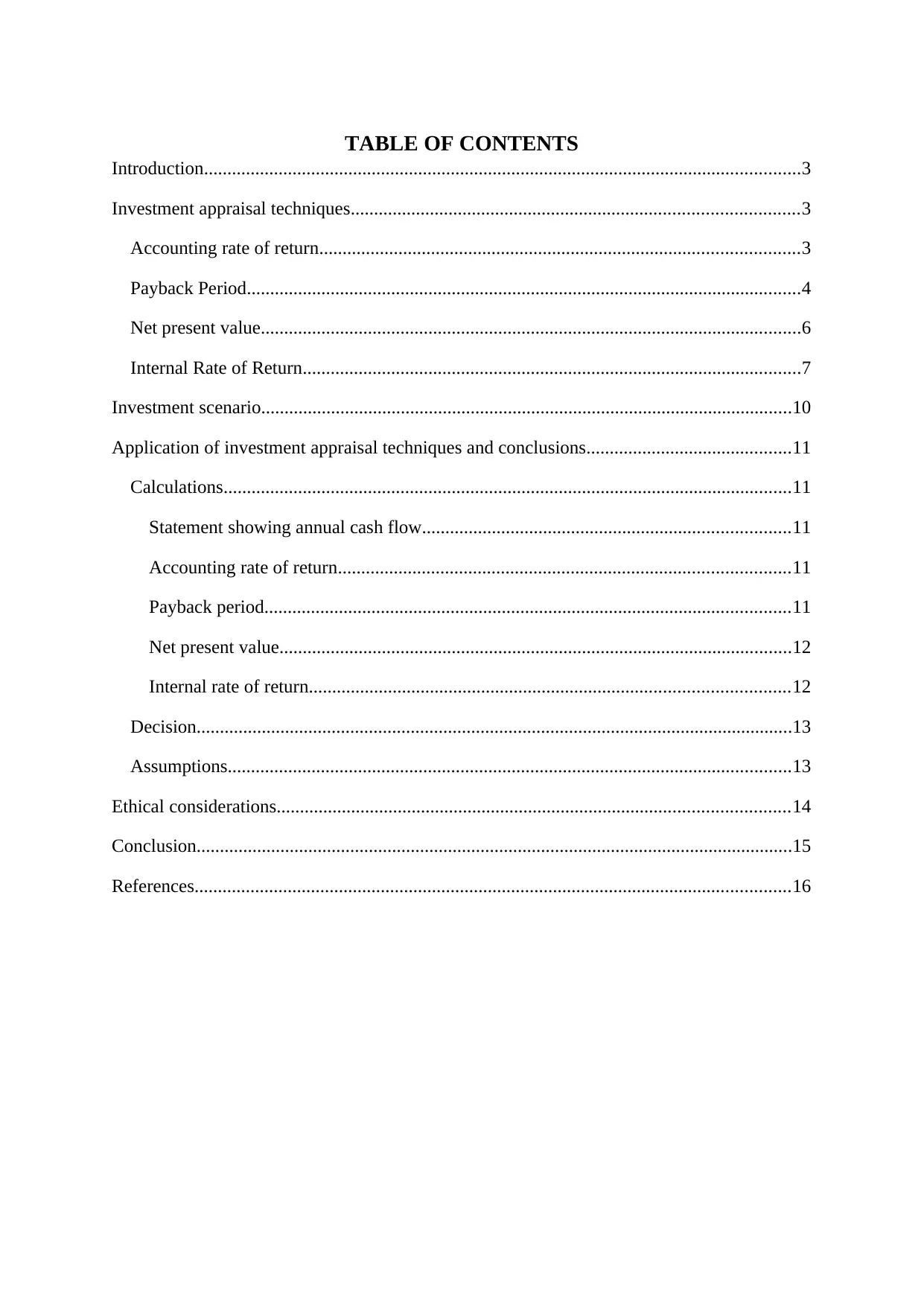
TABLE OF CONTENTS
Introduction................................................................................................................................3
Investment appraisal techniques................................................................................................3
Accounting rate of return.......................................................................................................3
Payback Period.......................................................................................................................4
Net present value....................................................................................................................6
Internal Rate of Return...........................................................................................................7
Investment scenario..................................................................................................................10
Application of investment appraisal techniques and conclusions............................................11
Calculations..........................................................................................................................11
Statement showing annual cash flow...............................................................................11
Accounting rate of return.................................................................................................11
Payback period.................................................................................................................11
Net present value..............................................................................................................12
Internal rate of return.......................................................................................................12
Decision................................................................................................................................13
Assumptions.........................................................................................................................13
Ethical considerations..............................................................................................................14
Conclusion................................................................................................................................15
References................................................................................................................................16
Introduction................................................................................................................................3
Investment appraisal techniques................................................................................................3
Accounting rate of return.......................................................................................................3
Payback Period.......................................................................................................................4
Net present value....................................................................................................................6
Internal Rate of Return...........................................................................................................7
Investment scenario..................................................................................................................10
Application of investment appraisal techniques and conclusions............................................11
Calculations..........................................................................................................................11
Statement showing annual cash flow...............................................................................11
Accounting rate of return.................................................................................................11
Payback period.................................................................................................................11
Net present value..............................................................................................................12
Internal rate of return.......................................................................................................12
Decision................................................................................................................................13
Assumptions.........................................................................................................................13
Ethical considerations..............................................................................................................14
Conclusion................................................................................................................................15
References................................................................................................................................16
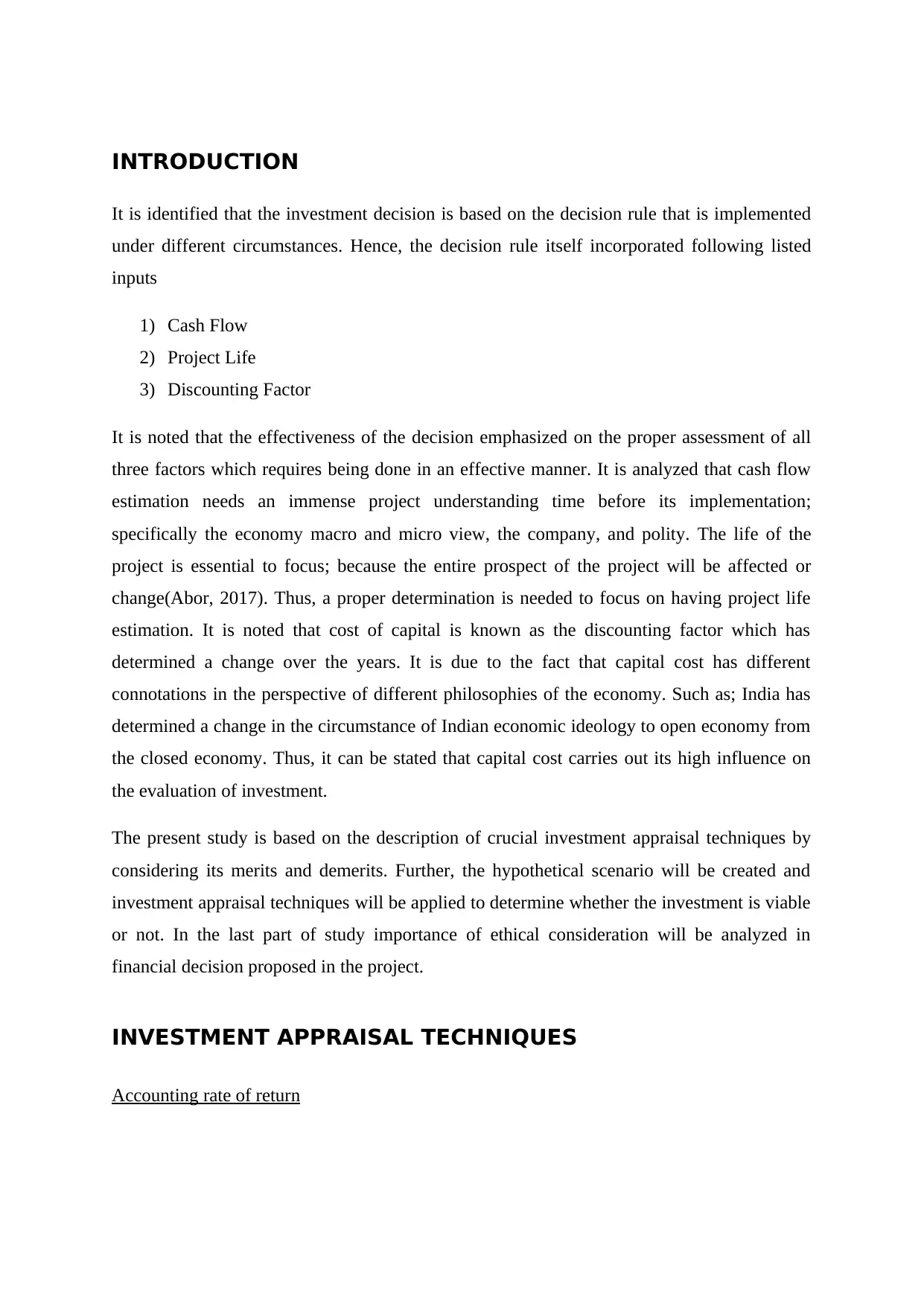
INTRODUCTION
It is identified that the investment decision is based on the decision rule that is implemented
under different circumstances. Hence, the decision rule itself incorporated following listed
inputs
1) Cash Flow
2) Project Life
3) Discounting Factor
It is noted that the effectiveness of the decision emphasized on the proper assessment of all
three factors which requires being done in an effective manner. It is analyzed that cash flow
estimation needs an immense project understanding time before its implementation;
specifically the economy macro and micro view, the company, and polity. The life of the
project is essential to focus; because the entire prospect of the project will be affected or
change(Abor, 2017). Thus, a proper determination is needed to focus on having project life
estimation. It is noted that cost of capital is known as the discounting factor which has
determined a change over the years. It is due to the fact that capital cost has different
connotations in the perspective of different philosophies of the economy. Such as; India has
determined a change in the circumstance of Indian economic ideology to open economy from
the closed economy. Thus, it can be stated that capital cost carries out its high influence on
the evaluation of investment.
The present study is based on the description of crucial investment appraisal techniques by
considering its merits and demerits. Further, the hypothetical scenario will be created and
investment appraisal techniques will be applied to determine whether the investment is viable
or not. In the last part of study importance of ethical consideration will be analyzed in
financial decision proposed in the project.
INVESTMENT APPRAISAL TECHNIQUES
Accounting rate of return
It is identified that the investment decision is based on the decision rule that is implemented
under different circumstances. Hence, the decision rule itself incorporated following listed
inputs
1) Cash Flow
2) Project Life
3) Discounting Factor
It is noted that the effectiveness of the decision emphasized on the proper assessment of all
three factors which requires being done in an effective manner. It is analyzed that cash flow
estimation needs an immense project understanding time before its implementation;
specifically the economy macro and micro view, the company, and polity. The life of the
project is essential to focus; because the entire prospect of the project will be affected or
change(Abor, 2017). Thus, a proper determination is needed to focus on having project life
estimation. It is noted that cost of capital is known as the discounting factor which has
determined a change over the years. It is due to the fact that capital cost has different
connotations in the perspective of different philosophies of the economy. Such as; India has
determined a change in the circumstance of Indian economic ideology to open economy from
the closed economy. Thus, it can be stated that capital cost carries out its high influence on
the evaluation of investment.
The present study is based on the description of crucial investment appraisal techniques by
considering its merits and demerits. Further, the hypothetical scenario will be created and
investment appraisal techniques will be applied to determine whether the investment is viable
or not. In the last part of study importance of ethical consideration will be analyzed in
financial decision proposed in the project.
INVESTMENT APPRAISAL TECHNIQUES
Accounting rate of return
⊘ This is a preview!⊘
Do you want full access?
Subscribe today to unlock all pages.

Trusted by 1+ million students worldwide
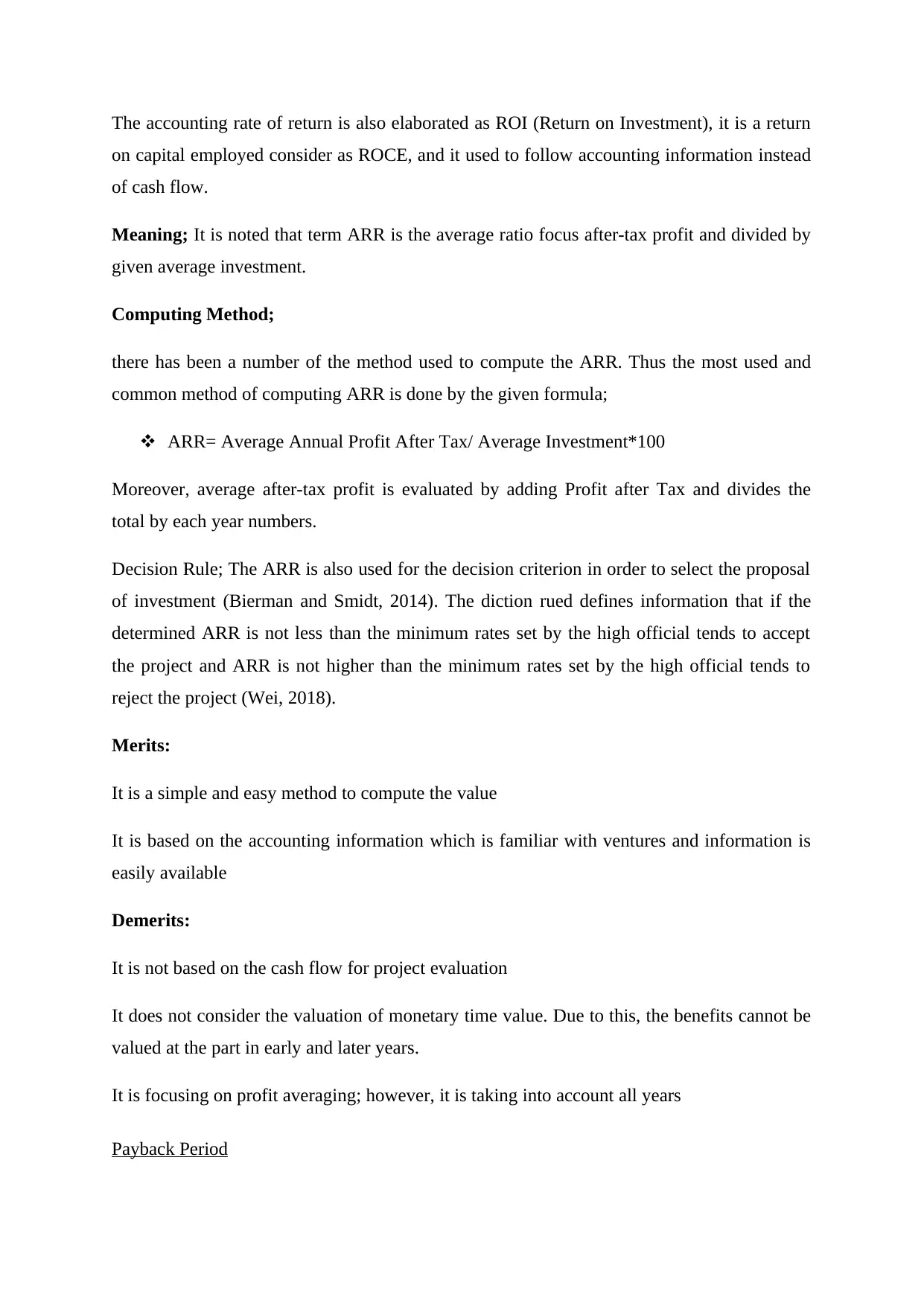
The accounting rate of return is also elaborated as ROI (Return on Investment), it is a return
on capital employed consider as ROCE, and it used to follow accounting information instead
of cash flow.
Meaning; It is noted that term ARR is the average ratio focus after-tax profit and divided by
given average investment.
Computing Method;
there has been a number of the method used to compute the ARR. Thus the most used and
common method of computing ARR is done by the given formula;
ARR= Average Annual Profit After Tax/ Average Investment*100
Moreover, average after-tax profit is evaluated by adding Profit after Tax and divides the
total by each year numbers.
Decision Rule; The ARR is also used for the decision criterion in order to select the proposal
of investment (Bierman and Smidt, 2014). The diction rued defines information that if the
determined ARR is not less than the minimum rates set by the high official tends to accept
the project and ARR is not higher than the minimum rates set by the high official tends to
reject the project (Wei, 2018).
Merits:
It is a simple and easy method to compute the value
It is based on the accounting information which is familiar with ventures and information is
easily available
Demerits:
It is not based on the cash flow for project evaluation
It does not consider the valuation of monetary time value. Due to this, the benefits cannot be
valued at the part in early and later years.
It is focusing on profit averaging; however, it is taking into account all years
Payback Period
on capital employed consider as ROCE, and it used to follow accounting information instead
of cash flow.
Meaning; It is noted that term ARR is the average ratio focus after-tax profit and divided by
given average investment.
Computing Method;
there has been a number of the method used to compute the ARR. Thus the most used and
common method of computing ARR is done by the given formula;
ARR= Average Annual Profit After Tax/ Average Investment*100
Moreover, average after-tax profit is evaluated by adding Profit after Tax and divides the
total by each year numbers.
Decision Rule; The ARR is also used for the decision criterion in order to select the proposal
of investment (Bierman and Smidt, 2014). The diction rued defines information that if the
determined ARR is not less than the minimum rates set by the high official tends to accept
the project and ARR is not higher than the minimum rates set by the high official tends to
reject the project (Wei, 2018).
Merits:
It is a simple and easy method to compute the value
It is based on the accounting information which is familiar with ventures and information is
easily available
Demerits:
It is not based on the cash flow for project evaluation
It does not consider the valuation of monetary time value. Due to this, the benefits cannot be
valued at the part in early and later years.
It is focusing on profit averaging; however, it is taking into account all years
Payback Period
Paraphrase This Document
Need a fresh take? Get an instant paraphrase of this document with our AI Paraphraser
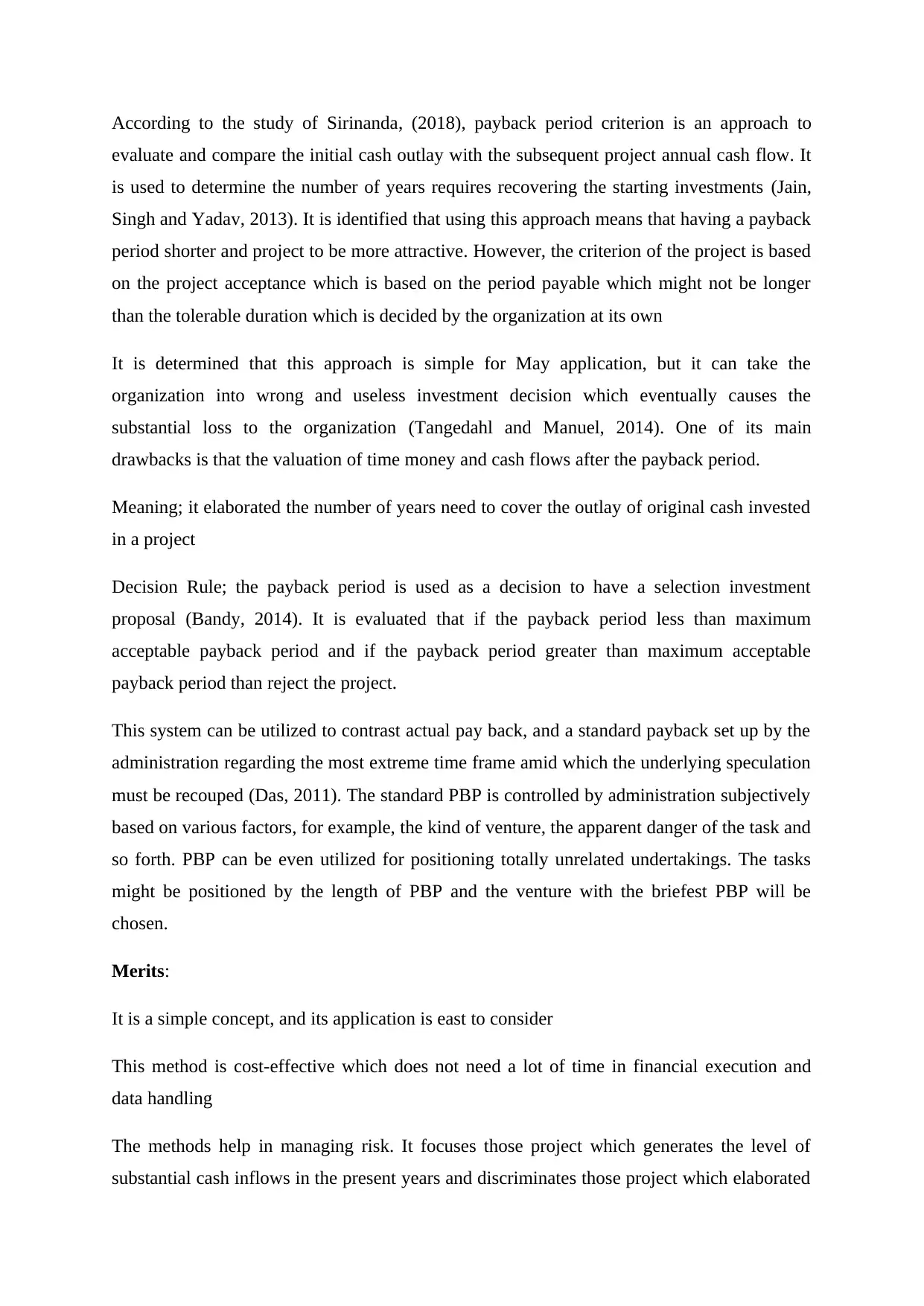
According to the study of Sirinanda, (2018), payback period criterion is an approach to
evaluate and compare the initial cash outlay with the subsequent project annual cash flow. It
is used to determine the number of years requires recovering the starting investments (Jain,
Singh and Yadav, 2013). It is identified that using this approach means that having a payback
period shorter and project to be more attractive. However, the criterion of the project is based
on the project acceptance which is based on the period payable which might not be longer
than the tolerable duration which is decided by the organization at its own
It is determined that this approach is simple for May application, but it can take the
organization into wrong and useless investment decision which eventually causes the
substantial loss to the organization (Tangedahl and Manuel, 2014). One of its main
drawbacks is that the valuation of time money and cash flows after the payback period.
Meaning; it elaborated the number of years need to cover the outlay of original cash invested
in a project
Decision Rule; the payback period is used as a decision to have a selection investment
proposal (Bandy, 2014). It is evaluated that if the payback period less than maximum
acceptable payback period and if the payback period greater than maximum acceptable
payback period than reject the project.
This system can be utilized to contrast actual pay back, and a standard payback set up by the
administration regarding the most extreme time frame amid which the underlying speculation
must be recouped (Das, 2011). The standard PBP is controlled by administration subjectively
based on various factors, for example, the kind of venture, the apparent danger of the task and
so forth. PBP can be even utilized for positioning totally unrelated undertakings. The tasks
might be positioned by the length of PBP and the venture with the briefest PBP will be
chosen.
Merits:
It is a simple concept, and its application is east to consider
This method is cost-effective which does not need a lot of time in financial execution and
data handling
The methods help in managing risk. It focuses those project which generates the level of
substantial cash inflows in the present years and discriminates those project which elaborated
evaluate and compare the initial cash outlay with the subsequent project annual cash flow. It
is used to determine the number of years requires recovering the starting investments (Jain,
Singh and Yadav, 2013). It is identified that using this approach means that having a payback
period shorter and project to be more attractive. However, the criterion of the project is based
on the project acceptance which is based on the period payable which might not be longer
than the tolerable duration which is decided by the organization at its own
It is determined that this approach is simple for May application, but it can take the
organization into wrong and useless investment decision which eventually causes the
substantial loss to the organization (Tangedahl and Manuel, 2014). One of its main
drawbacks is that the valuation of time money and cash flows after the payback period.
Meaning; it elaborated the number of years need to cover the outlay of original cash invested
in a project
Decision Rule; the payback period is used as a decision to have a selection investment
proposal (Bandy, 2014). It is evaluated that if the payback period less than maximum
acceptable payback period and if the payback period greater than maximum acceptable
payback period than reject the project.
This system can be utilized to contrast actual pay back, and a standard payback set up by the
administration regarding the most extreme time frame amid which the underlying speculation
must be recouped (Das, 2011). The standard PBP is controlled by administration subjectively
based on various factors, for example, the kind of venture, the apparent danger of the task and
so forth. PBP can be even utilized for positioning totally unrelated undertakings. The tasks
might be positioned by the length of PBP and the venture with the briefest PBP will be
chosen.
Merits:
It is a simple concept, and its application is east to consider
This method is cost-effective which does not need a lot of time in financial execution and
data handling
The methods help in managing risk. It focuses those project which generates the level of
substantial cash inflows in the present years and discriminates those project which elaborated
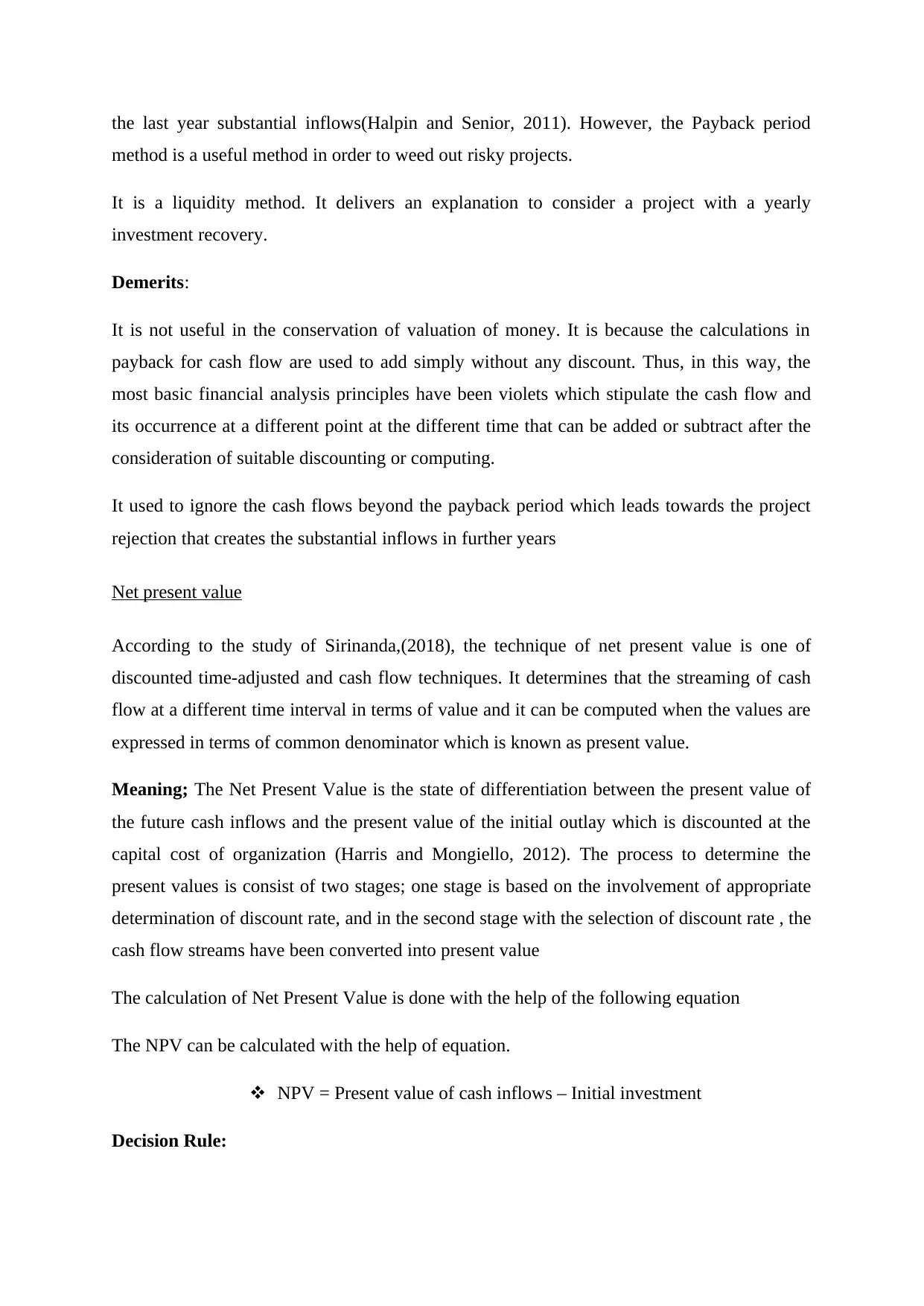
the last year substantial inflows(Halpin and Senior, 2011). However, the Payback period
method is a useful method in order to weed out risky projects.
It is a liquidity method. It delivers an explanation to consider a project with a yearly
investment recovery.
Demerits:
It is not useful in the conservation of valuation of money. It is because the calculations in
payback for cash flow are used to add simply without any discount. Thus, in this way, the
most basic financial analysis principles have been violets which stipulate the cash flow and
its occurrence at a different point at the different time that can be added or subtract after the
consideration of suitable discounting or computing.
It used to ignore the cash flows beyond the payback period which leads towards the project
rejection that creates the substantial inflows in further years
Net present value
According to the study of Sirinanda,(2018), the technique of net present value is one of
discounted time-adjusted and cash flow techniques. It determines that the streaming of cash
flow at a different time interval in terms of value and it can be computed when the values are
expressed in terms of common denominator which is known as present value.
Meaning; The Net Present Value is the state of differentiation between the present value of
the future cash inflows and the present value of the initial outlay which is discounted at the
capital cost of organization (Harris and Mongiello, 2012). The process to determine the
present values is consist of two stages; one stage is based on the involvement of appropriate
determination of discount rate, and in the second stage with the selection of discount rate , the
cash flow streams have been converted into present value
The calculation of Net Present Value is done with the help of the following equation
The NPV can be calculated with the help of equation.
NPV = Present value of cash inflows – Initial investment
Decision Rule:
method is a useful method in order to weed out risky projects.
It is a liquidity method. It delivers an explanation to consider a project with a yearly
investment recovery.
Demerits:
It is not useful in the conservation of valuation of money. It is because the calculations in
payback for cash flow are used to add simply without any discount. Thus, in this way, the
most basic financial analysis principles have been violets which stipulate the cash flow and
its occurrence at a different point at the different time that can be added or subtract after the
consideration of suitable discounting or computing.
It used to ignore the cash flows beyond the payback period which leads towards the project
rejection that creates the substantial inflows in further years
Net present value
According to the study of Sirinanda,(2018), the technique of net present value is one of
discounted time-adjusted and cash flow techniques. It determines that the streaming of cash
flow at a different time interval in terms of value and it can be computed when the values are
expressed in terms of common denominator which is known as present value.
Meaning; The Net Present Value is the state of differentiation between the present value of
the future cash inflows and the present value of the initial outlay which is discounted at the
capital cost of organization (Harris and Mongiello, 2012). The process to determine the
present values is consist of two stages; one stage is based on the involvement of appropriate
determination of discount rate, and in the second stage with the selection of discount rate , the
cash flow streams have been converted into present value
The calculation of Net Present Value is done with the help of the following equation
The NPV can be calculated with the help of equation.
NPV = Present value of cash inflows – Initial investment
Decision Rule:
⊘ This is a preview!⊘
Do you want full access?
Subscribe today to unlock all pages.

Trusted by 1+ million students worldwide
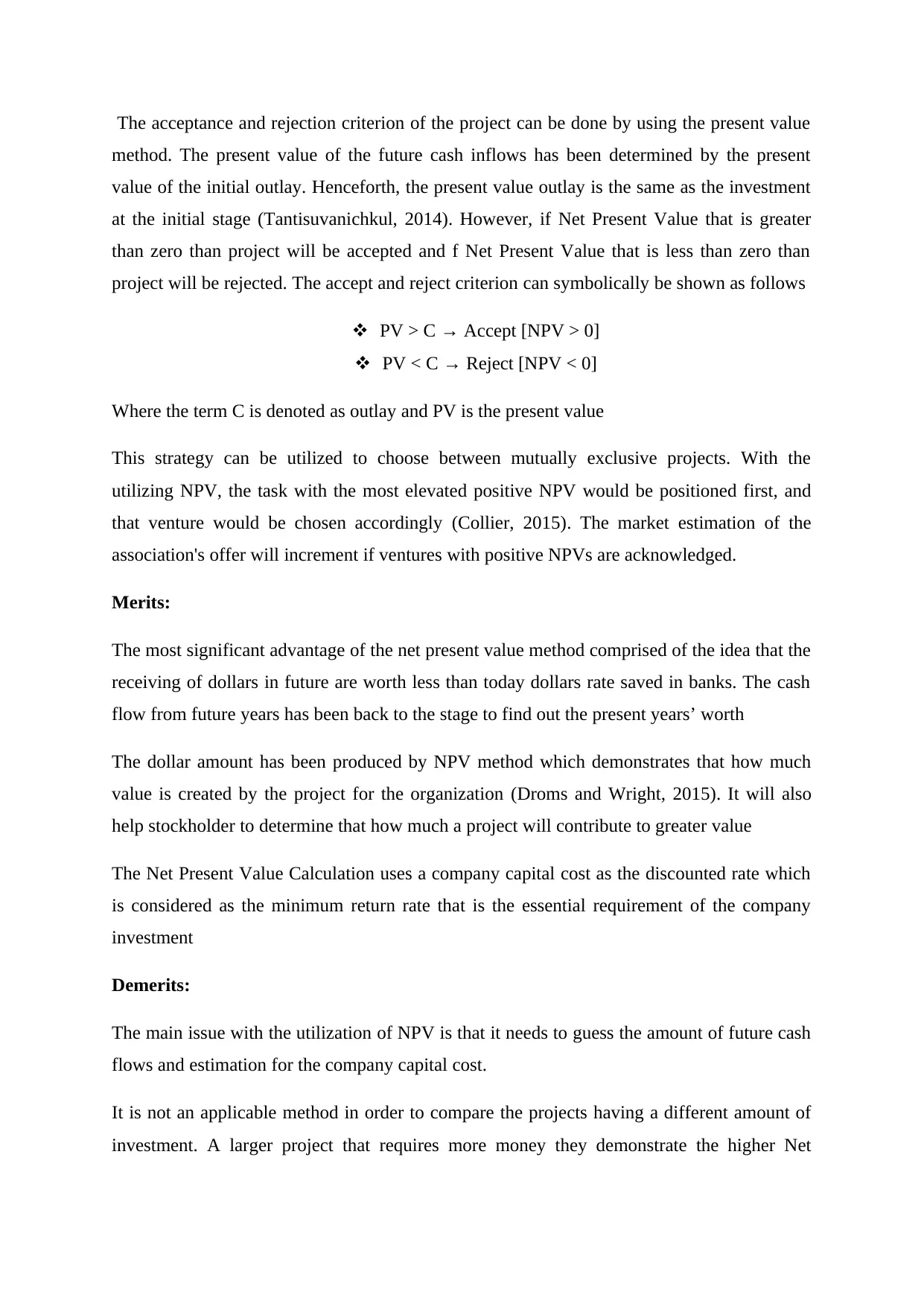
The acceptance and rejection criterion of the project can be done by using the present value
method. The present value of the future cash inflows has been determined by the present
value of the initial outlay. Henceforth, the present value outlay is the same as the investment
at the initial stage (Tantisuvanichkul, 2014). However, if Net Present Value that is greater
than zero than project will be accepted and f Net Present Value that is less than zero than
project will be rejected. The accept and reject criterion can symbolically be shown as follows
PV > C → Accept [NPV > 0]
PV < C → Reject [NPV < 0]
Where the term C is denoted as outlay and PV is the present value
This strategy can be utilized to choose between mutually exclusive projects. With the
utilizing NPV, the task with the most elevated positive NPV would be positioned first, and
that venture would be chosen accordingly (Collier, 2015). The market estimation of the
association's offer will increment if ventures with positive NPVs are acknowledged.
Merits:
The most significant advantage of the net present value method comprised of the idea that the
receiving of dollars in future are worth less than today dollars rate saved in banks. The cash
flow from future years has been back to the stage to find out the present years’ worth
The dollar amount has been produced by NPV method which demonstrates that how much
value is created by the project for the organization (Droms and Wright, 2015). It will also
help stockholder to determine that how much a project will contribute to greater value
The Net Present Value Calculation uses a company capital cost as the discounted rate which
is considered as the minimum return rate that is the essential requirement of the company
investment
Demerits:
The main issue with the utilization of NPV is that it needs to guess the amount of future cash
flows and estimation for the company capital cost.
It is not an applicable method in order to compare the projects having a different amount of
investment. A larger project that requires more money they demonstrate the higher Net
method. The present value of the future cash inflows has been determined by the present
value of the initial outlay. Henceforth, the present value outlay is the same as the investment
at the initial stage (Tantisuvanichkul, 2014). However, if Net Present Value that is greater
than zero than project will be accepted and f Net Present Value that is less than zero than
project will be rejected. The accept and reject criterion can symbolically be shown as follows
PV > C → Accept [NPV > 0]
PV < C → Reject [NPV < 0]
Where the term C is denoted as outlay and PV is the present value
This strategy can be utilized to choose between mutually exclusive projects. With the
utilizing NPV, the task with the most elevated positive NPV would be positioned first, and
that venture would be chosen accordingly (Collier, 2015). The market estimation of the
association's offer will increment if ventures with positive NPVs are acknowledged.
Merits:
The most significant advantage of the net present value method comprised of the idea that the
receiving of dollars in future are worth less than today dollars rate saved in banks. The cash
flow from future years has been back to the stage to find out the present years’ worth
The dollar amount has been produced by NPV method which demonstrates that how much
value is created by the project for the organization (Droms and Wright, 2015). It will also
help stockholder to determine that how much a project will contribute to greater value
The Net Present Value Calculation uses a company capital cost as the discounted rate which
is considered as the minimum return rate that is the essential requirement of the company
investment
Demerits:
The main issue with the utilization of NPV is that it needs to guess the amount of future cash
flows and estimation for the company capital cost.
It is not an applicable method in order to compare the projects having a different amount of
investment. A larger project that requires more money they demonstrate the higher Net
Paraphrase This Document
Need a fresh take? Get an instant paraphrase of this document with our AI Paraphraser
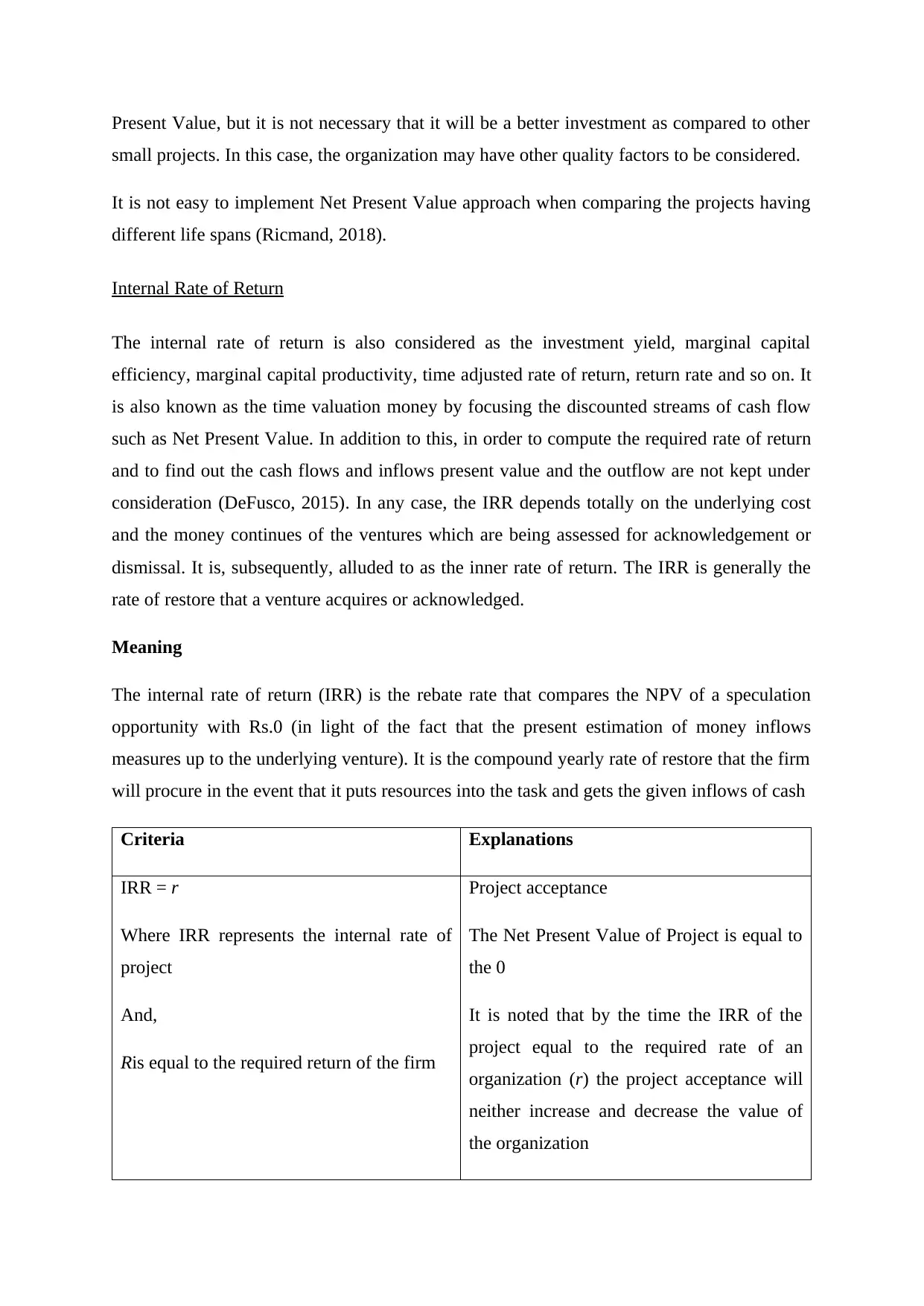
Present Value, but it is not necessary that it will be a better investment as compared to other
small projects. In this case, the organization may have other quality factors to be considered.
It is not easy to implement Net Present Value approach when comparing the projects having
different life spans (Ricmand, 2018).
Internal Rate of Return
The internal rate of return is also considered as the investment yield, marginal capital
efficiency, marginal capital productivity, time adjusted rate of return, return rate and so on. It
is also known as the time valuation money by focusing the discounted streams of cash flow
such as Net Present Value. In addition to this, in order to compute the required rate of return
and to find out the cash flows and inflows present value and the outflow are not kept under
consideration (DeFusco, 2015). In any case, the IRR depends totally on the underlying cost
and the money continues of the ventures which are being assessed for acknowledgement or
dismissal. It is, subsequently, alluded to as the inner rate of return. The IRR is generally the
rate of restore that a venture acquires or acknowledged.
Meaning
The internal rate of return (IRR) is the rebate rate that compares the NPV of a speculation
opportunity with Rs.0 (in light of the fact that the present estimation of money inflows
measures up to the underlying venture). It is the compound yearly rate of restore that the firm
will procure in the event that it puts resources into the task and gets the given inflows of cash
Criteria Explanations
IRR = r
Where IRR represents the internal rate of
project
And,
Ris equal to the required return of the firm
Project acceptance
The Net Present Value of Project is equal to
the 0
It is noted that by the time the IRR of the
project equal to the required rate of an
organization (r) the project acceptance will
neither increase and decrease the value of
the organization
small projects. In this case, the organization may have other quality factors to be considered.
It is not easy to implement Net Present Value approach when comparing the projects having
different life spans (Ricmand, 2018).
Internal Rate of Return
The internal rate of return is also considered as the investment yield, marginal capital
efficiency, marginal capital productivity, time adjusted rate of return, return rate and so on. It
is also known as the time valuation money by focusing the discounted streams of cash flow
such as Net Present Value. In addition to this, in order to compute the required rate of return
and to find out the cash flows and inflows present value and the outflow are not kept under
consideration (DeFusco, 2015). In any case, the IRR depends totally on the underlying cost
and the money continues of the ventures which are being assessed for acknowledgement or
dismissal. It is, subsequently, alluded to as the inner rate of return. The IRR is generally the
rate of restore that a venture acquires or acknowledged.
Meaning
The internal rate of return (IRR) is the rebate rate that compares the NPV of a speculation
opportunity with Rs.0 (in light of the fact that the present estimation of money inflows
measures up to the underlying venture). It is the compound yearly rate of restore that the firm
will procure in the event that it puts resources into the task and gets the given inflows of cash
Criteria Explanations
IRR = r
Where IRR represents the internal rate of
project
And,
Ris equal to the required return of the firm
Project acceptance
The Net Present Value of Project is equal to
the 0
It is noted that by the time the IRR of the
project equal to the required rate of an
organization (r) the project acceptance will
neither increase and decrease the value of
the organization
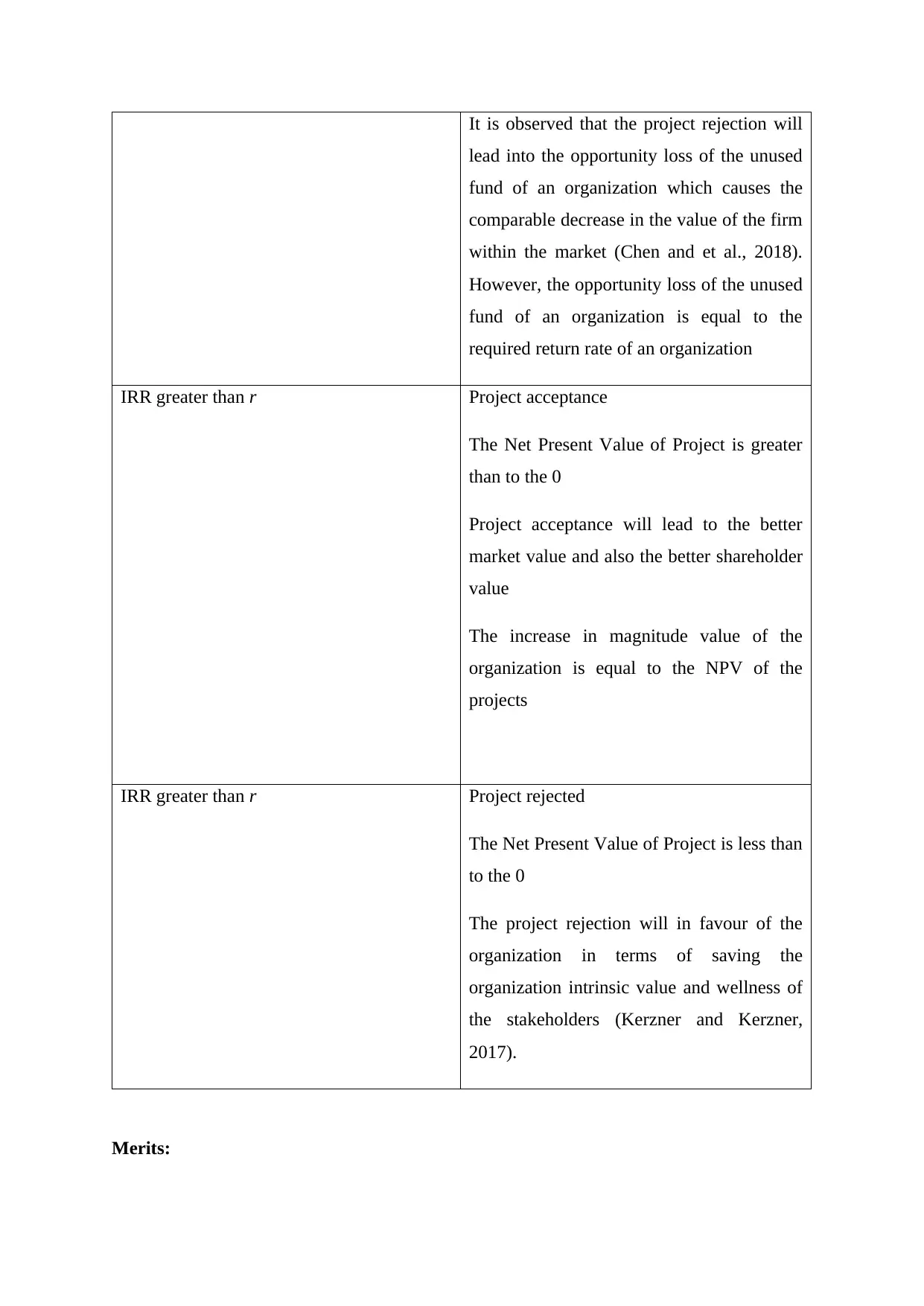
It is observed that the project rejection will
lead into the opportunity loss of the unused
fund of an organization which causes the
comparable decrease in the value of the firm
within the market (Chen and et al., 2018).
However, the opportunity loss of the unused
fund of an organization is equal to the
required return rate of an organization
IRR greater than r Project acceptance
The Net Present Value of Project is greater
than to the 0
Project acceptance will lead to the better
market value and also the better shareholder
value
The increase in magnitude value of the
organization is equal to the NPV of the
projects
IRR greater than r Project rejected
The Net Present Value of Project is less than
to the 0
The project rejection will in favour of the
organization in terms of saving the
organization intrinsic value and wellness of
the stakeholders (Kerzner and Kerzner,
2017).
Merits:
lead into the opportunity loss of the unused
fund of an organization which causes the
comparable decrease in the value of the firm
within the market (Chen and et al., 2018).
However, the opportunity loss of the unused
fund of an organization is equal to the
required return rate of an organization
IRR greater than r Project acceptance
The Net Present Value of Project is greater
than to the 0
Project acceptance will lead to the better
market value and also the better shareholder
value
The increase in magnitude value of the
organization is equal to the NPV of the
projects
IRR greater than r Project rejected
The Net Present Value of Project is less than
to the 0
The project rejection will in favour of the
organization in terms of saving the
organization intrinsic value and wellness of
the stakeholders (Kerzner and Kerzner,
2017).
Merits:
⊘ This is a preview!⊘
Do you want full access?
Subscribe today to unlock all pages.

Trusted by 1+ million students worldwide
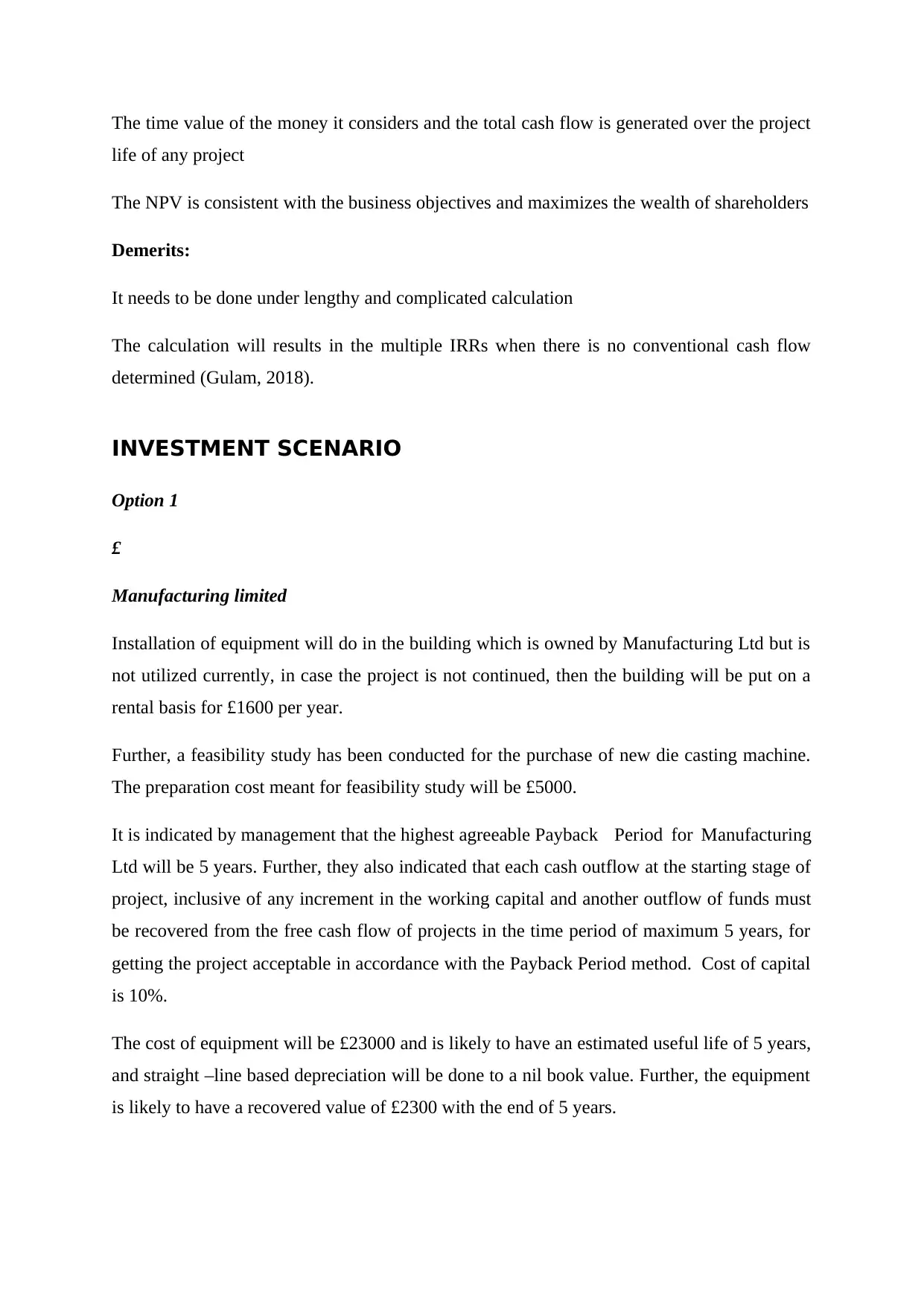
The time value of the money it considers and the total cash flow is generated over the project
life of any project
The NPV is consistent with the business objectives and maximizes the wealth of shareholders
Demerits:
It needs to be done under lengthy and complicated calculation
The calculation will results in the multiple IRRs when there is no conventional cash flow
determined (Gulam, 2018).
INVESTMENT SCENARIO
Option 1
£
Manufacturing limited
Installation of equipment will do in the building which is owned by Manufacturing Ltd but is
not utilized currently, in case the project is not continued, then the building will be put on a
rental basis for £1600 per year.
Further, a feasibility study has been conducted for the purchase of new die casting machine.
The preparation cost meant for feasibility study will be £5000.
It is indicated by management that the highest agreeable Payback Period for Manufacturing
Ltd will be 5 years. Further, they also indicated that each cash outflow at the starting stage of
project, inclusive of any increment in the working capital and another outflow of funds must
be recovered from the free cash flow of projects in the time period of maximum 5 years, for
getting the project acceptable in accordance with the Payback Period method. Cost of capital
is 10%.
The cost of equipment will be £23000 and is likely to have an estimated useful life of 5 years,
and straight –line based depreciation will be done to a nil book value. Further, the equipment
is likely to have a recovered value of £2300 with the end of 5 years.
life of any project
The NPV is consistent with the business objectives and maximizes the wealth of shareholders
Demerits:
It needs to be done under lengthy and complicated calculation
The calculation will results in the multiple IRRs when there is no conventional cash flow
determined (Gulam, 2018).
INVESTMENT SCENARIO
Option 1
£
Manufacturing limited
Installation of equipment will do in the building which is owned by Manufacturing Ltd but is
not utilized currently, in case the project is not continued, then the building will be put on a
rental basis for £1600 per year.
Further, a feasibility study has been conducted for the purchase of new die casting machine.
The preparation cost meant for feasibility study will be £5000.
It is indicated by management that the highest agreeable Payback Period for Manufacturing
Ltd will be 5 years. Further, they also indicated that each cash outflow at the starting stage of
project, inclusive of any increment in the working capital and another outflow of funds must
be recovered from the free cash flow of projects in the time period of maximum 5 years, for
getting the project acceptable in accordance with the Payback Period method. Cost of capital
is 10%.
The cost of equipment will be £23000 and is likely to have an estimated useful life of 5 years,
and straight –line based depreciation will be done to a nil book value. Further, the equipment
is likely to have a recovered value of £2300 with the end of 5 years.
Paraphrase This Document
Need a fresh take? Get an instant paraphrase of this document with our AI Paraphraser
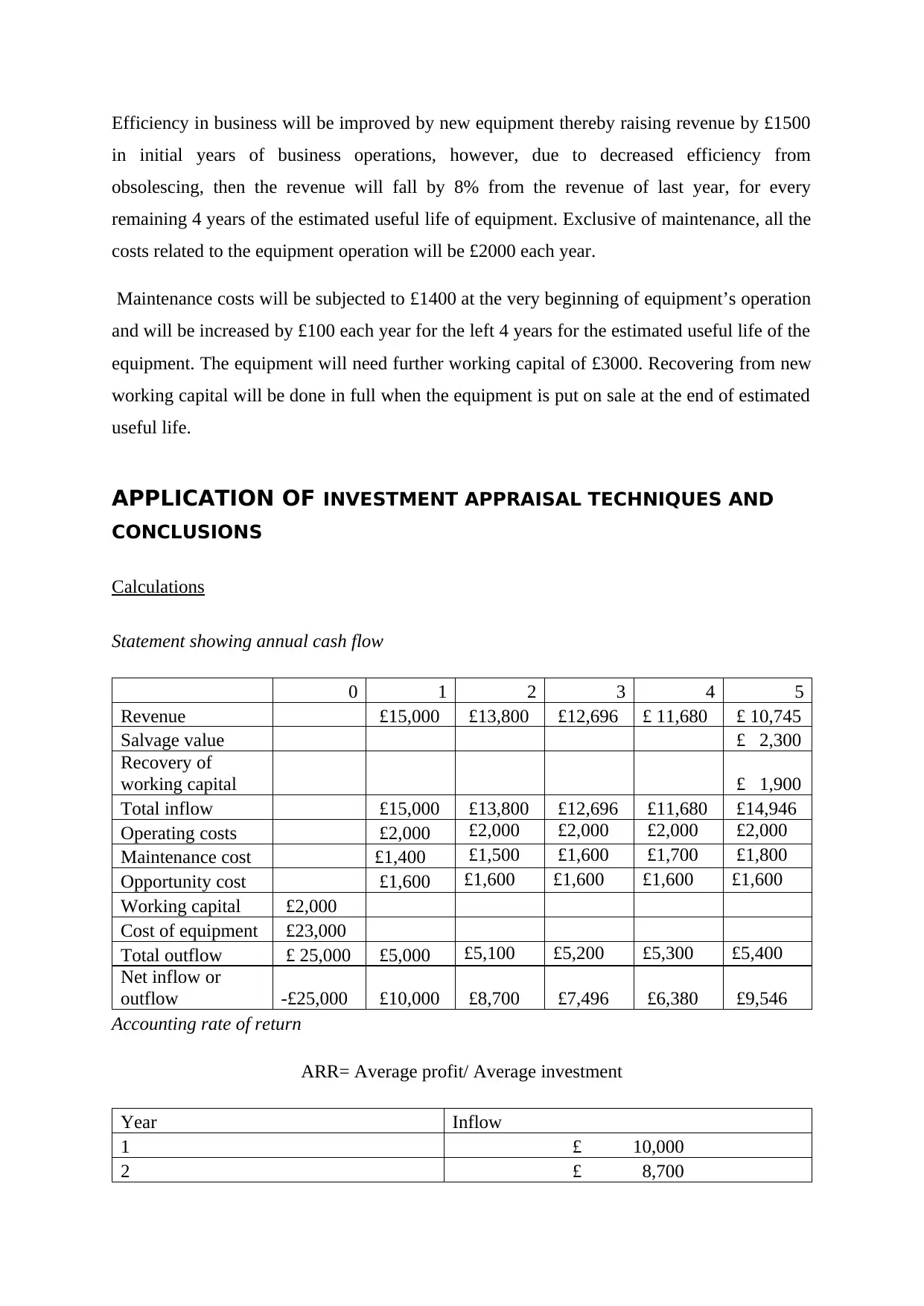
Efficiency in business will be improved by new equipment thereby raising revenue by £1500
in initial years of business operations, however, due to decreased efficiency from
obsolescing, then the revenue will fall by 8% from the revenue of last year, for every
remaining 4 years of the estimated useful life of equipment. Exclusive of maintenance, all the
costs related to the equipment operation will be £2000 each year.
Maintenance costs will be subjected to £1400 at the very beginning of equipment’s operation
and will be increased by £100 each year for the left 4 years for the estimated useful life of the
equipment. The equipment will need further working capital of £3000. Recovering from new
working capital will be done in full when the equipment is put on sale at the end of estimated
useful life.
APPLICATION OF INVESTMENT APPRAISAL TECHNIQUES AND
CONCLUSIONS
Calculations
Statement showing annual cash flow
0 1 2 3 4 5
Revenue £15,000 £13,800 £12,696 £ 11,680 £ 10,745
Salvage value £ 2,300
Recovery of
working capital £ 1,900
Total inflow £15,000 £13,800 £12,696 £11,680 £14,946
Operating costs £2,000 £2,000 £2,000 £2,000 £2,000
Maintenance cost £1,400 £1,500 £1,600 £1,700 £1,800
Opportunity cost £1,600 £1,600 £1,600 £1,600 £1,600
Working capital £2,000
Cost of equipment £23,000
Total outflow £ 25,000 £5,000 £5,100 £5,200 £5,300 £5,400
Net inflow or
outflow -£25,000 £10,000 £8,700 £7,496 £6,380 £9,546
Accounting rate of return
ARR= Average profit/ Average investment
Year Inflow
1 £ 10,000
2 £ 8,700
in initial years of business operations, however, due to decreased efficiency from
obsolescing, then the revenue will fall by 8% from the revenue of last year, for every
remaining 4 years of the estimated useful life of equipment. Exclusive of maintenance, all the
costs related to the equipment operation will be £2000 each year.
Maintenance costs will be subjected to £1400 at the very beginning of equipment’s operation
and will be increased by £100 each year for the left 4 years for the estimated useful life of the
equipment. The equipment will need further working capital of £3000. Recovering from new
working capital will be done in full when the equipment is put on sale at the end of estimated
useful life.
APPLICATION OF INVESTMENT APPRAISAL TECHNIQUES AND
CONCLUSIONS
Calculations
Statement showing annual cash flow
0 1 2 3 4 5
Revenue £15,000 £13,800 £12,696 £ 11,680 £ 10,745
Salvage value £ 2,300
Recovery of
working capital £ 1,900
Total inflow £15,000 £13,800 £12,696 £11,680 £14,946
Operating costs £2,000 £2,000 £2,000 £2,000 £2,000
Maintenance cost £1,400 £1,500 £1,600 £1,700 £1,800
Opportunity cost £1,600 £1,600 £1,600 £1,600 £1,600
Working capital £2,000
Cost of equipment £23,000
Total outflow £ 25,000 £5,000 £5,100 £5,200 £5,300 £5,400
Net inflow or
outflow -£25,000 £10,000 £8,700 £7,496 £6,380 £9,546
Accounting rate of return
ARR= Average profit/ Average investment
Year Inflow
1 £ 10,000
2 £ 8,700
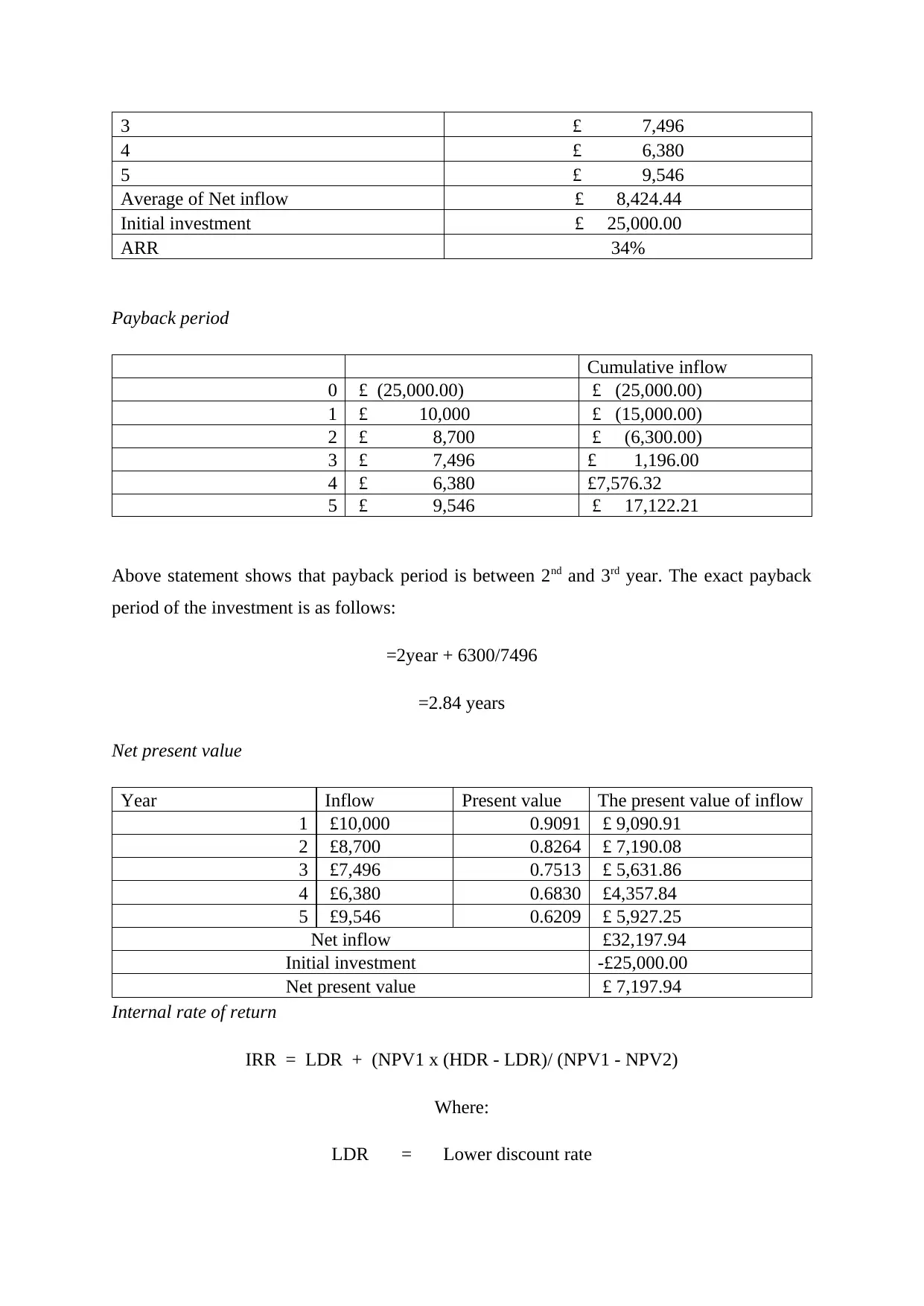
3 £ 7,496
4 £ 6,380
5 £ 9,546
Average of Net inflow £ 8,424.44
Initial investment £ 25,000.00
ARR 34%
Payback period
Cumulative inflow
0 £ (25,000.00) £ (25,000.00)
1 £ 10,000 £ (15,000.00)
2 £ 8,700 £ (6,300.00)
3 £ 7,496 £ 1,196.00
4 £ 6,380 £7,576.32
5 £ 9,546 £ 17,122.21
Above statement shows that payback period is between 2nd and 3rd year. The exact payback
period of the investment is as follows:
=2year + 6300/7496
=2.84 years
Net present value
Year Inflow Present value The present value of inflow
1 £10,000 0.9091 £ 9,090.91
2 £8,700 0.8264 £ 7,190.08
3 £7,496 0.7513 £ 5,631.86
4 £6,380 0.6830 £4,357.84
5 £9,546 0.6209 £ 5,927.25
Net inflow £32,197.94
Initial investment -£25,000.00
Net present value £ 7,197.94
Internal rate of return
IRR = LDR + (NPV1 x (HDR - LDR)/ (NPV1 - NPV2)
Where:
LDR = Lower discount rate
4 £ 6,380
5 £ 9,546
Average of Net inflow £ 8,424.44
Initial investment £ 25,000.00
ARR 34%
Payback period
Cumulative inflow
0 £ (25,000.00) £ (25,000.00)
1 £ 10,000 £ (15,000.00)
2 £ 8,700 £ (6,300.00)
3 £ 7,496 £ 1,196.00
4 £ 6,380 £7,576.32
5 £ 9,546 £ 17,122.21
Above statement shows that payback period is between 2nd and 3rd year. The exact payback
period of the investment is as follows:
=2year + 6300/7496
=2.84 years
Net present value
Year Inflow Present value The present value of inflow
1 £10,000 0.9091 £ 9,090.91
2 £8,700 0.8264 £ 7,190.08
3 £7,496 0.7513 £ 5,631.86
4 £6,380 0.6830 £4,357.84
5 £9,546 0.6209 £ 5,927.25
Net inflow £32,197.94
Initial investment -£25,000.00
Net present value £ 7,197.94
Internal rate of return
IRR = LDR + (NPV1 x (HDR - LDR)/ (NPV1 - NPV2)
Where:
LDR = Lower discount rate
⊘ This is a preview!⊘
Do you want full access?
Subscribe today to unlock all pages.

Trusted by 1+ million students worldwide
1 out of 17
Related Documents
Your All-in-One AI-Powered Toolkit for Academic Success.
+13062052269
info@desklib.com
Available 24*7 on WhatsApp / Email
![[object Object]](/_next/static/media/star-bottom.7253800d.svg)
Unlock your academic potential
Copyright © 2020–2025 A2Z Services. All Rights Reserved. Developed and managed by ZUCOL.





